Are you thinking about visiting North Cascades National Park but aren’t sure what to expect when you want to go? Then this guide is for you.
I’m James and I’m a national park expert. In this guide, I’ll go into detail for each month about exactly what to expect, so you can plan a trip that suits your needs.
The weather in North Cascades National Park is such a key factor as to what kind of visit you can have, so we’ll break this down month by down, as well as openings/ closings and what to see and do when you’re there.
‼️ If you just want a quick snapshot about my thoughts on the best time to visit North Cascades National Park, check out my Best Time to Go to North Cascades National Park guide. ‼️
Subscribe to daily national parks planning tips, travel inspiration and trip ideas and get instant access to the free PDF of this guide to
Visiting North Cascades National Park Throughout The Year
No time right now to learn about what to expect each month when visiting North Cascades National Park? Pin It and save it for later:
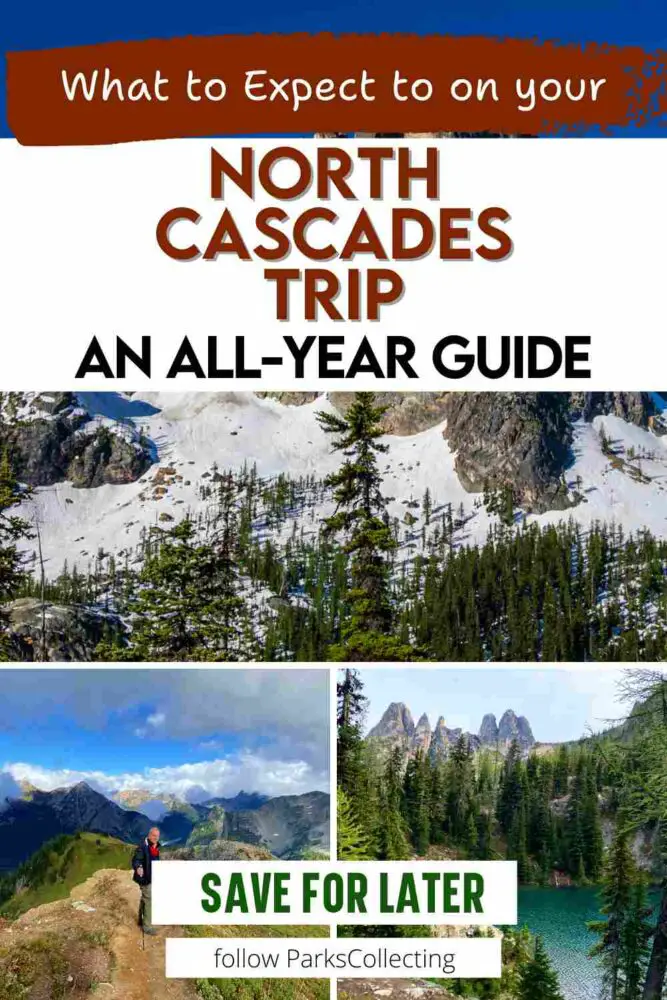
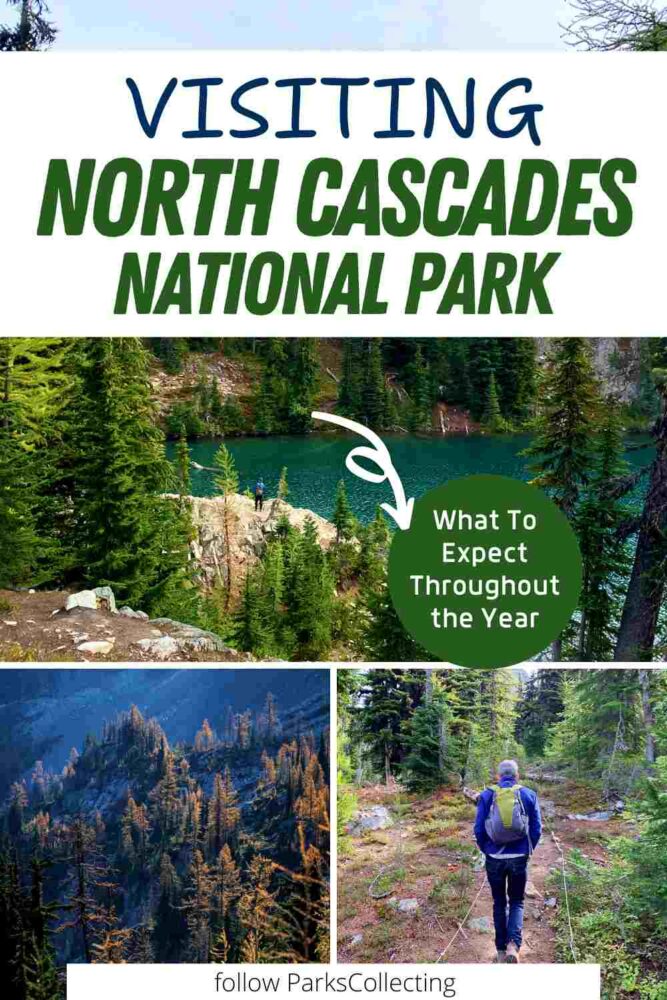
🛏️TOP HOTEL PICK: Check availability now
🚘FIND THE CHEAPEST CAR RENTAL: Search Discover Cars for the best deals
✈️FIND THE CHEAPEST FLIGHTS: Search Skyscanner for the best deals
🧳GET TRAVEL INSURANCE: Get insured with Travelex before you go
Table of Contents
North Cascades National Park – Spring (April – May)
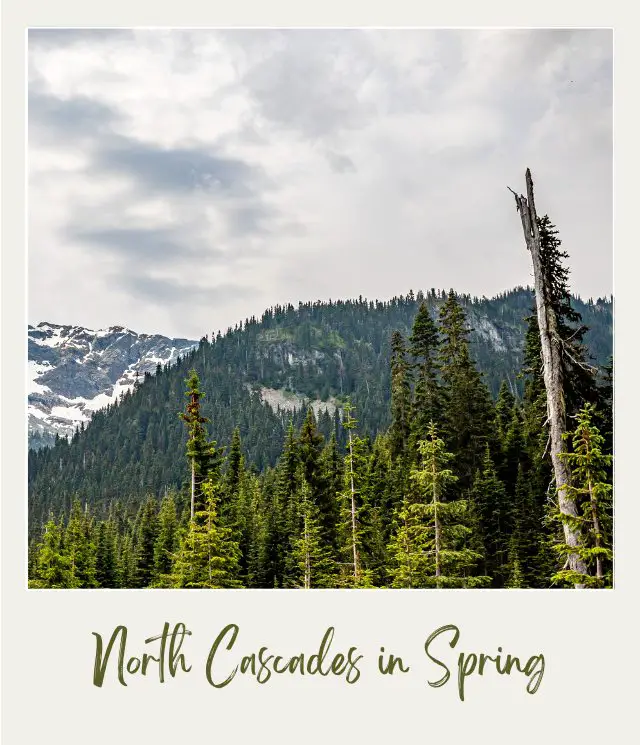
At this national park, spring occurs between April and May. In spring, you can expect the North Cascades weather to be warmer than between November and March. Generally, any heavy snow might start to clear in April on the lower elevations. May is the fifth-warmest month of the year.
Visiting North Cascades National Park in April
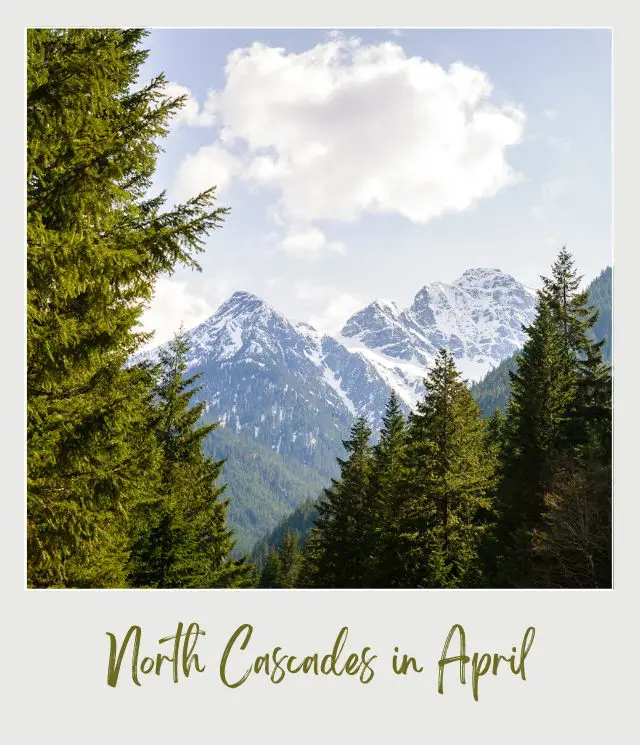
Visit North Cascades in April and you may find that the winter snow is finally starting to clear, particularly toward the end of the month, at the lower levels. Usually, the road beyond the Ross Lake trailhead is buried under snow between the middle of November and April. So, this is still likely to be the case – earlier in the month at least.
North Cascades National Park temperatures in April tend to hover between lows of about 16°F (-9°C) and highs of around 44°F (1°C). It’s comparatively cold here all year round.
During April, snow tends to switch to rain, though you might experience either, or both. With around 20 days of precipitation, April is drier than March, which is the wettest month. In terms of rainfall, April is average for this location. This is a pretty wet part of the planet!
Note that though highway 20 might open by the end of April, it may not do so until May. This depends on the weather. The trails may begin to clear by the end of the month, too, but this isn’t guaranteed either. At high elevations in particular, you can still expect a lot of snow coverage.
Pros
- Snow is starting to clear
- Precipitation levels are average
- Temperatures are warmer than winter
Cons
- Highways may still be closed
- Expect heavy snow coverage, especially in early April
- You cannot hike until at least late April, particularly at high elevations
Key Events in April:
✳️ National Park Week during the last complete week of April
Visiting North Cascades National Park in May
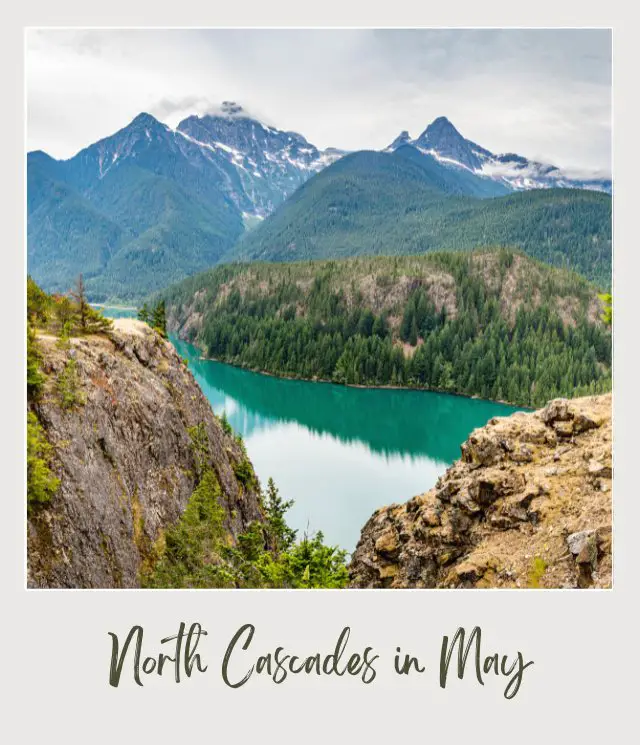
Only four months of the year – June, July, August and September – are warmer at North Cascades National Park than May. By this time, the roads should already be open or be opening, and much of the heavy snow that characterizes winter will be clearing.
At North Cascades in May, you can expect lows of around 21°F (-6°C), with highs of about 41°F (5°C). So while it’s definitely still chilly here, it’s not as cold as during the late fall, winter and early spring months.
May is also one of the slightly drier months here, with around 17 days of rain. So while you’ll still need wet weather gear, you can expect – on average – some dry days.
If you visit in May, prepare for the fact that some trails, especially at high elevations, might not have yet cleared. The same applies to the highways. It’s all weather dependent, so check the forecast before you visit.
The peak operation season for park facilities tends to run from late May to late September. You might be lucky enough to see wildflowers in some areas too.
Pros
- Fifth warmest month
- Lower than average precipitation levels
- Peak park operations season commences in late May
Cons
- It’s still relatively cold
- Higher elevations may still be snow-clad
- Trails and highways might still be closed, especially in early May
North Cascades National Park – Summer (June – August)
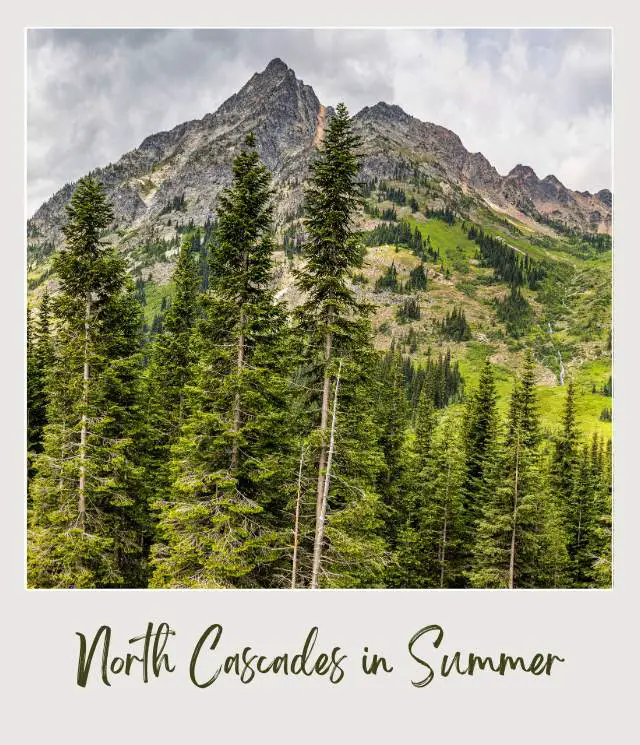
During summer, North Cascades National Park is warmer and drier than at any other time of the year. Summer here takes place in June, July and August, and this is the most popular time to visit the park.
Visiting North Cascades National Park – June
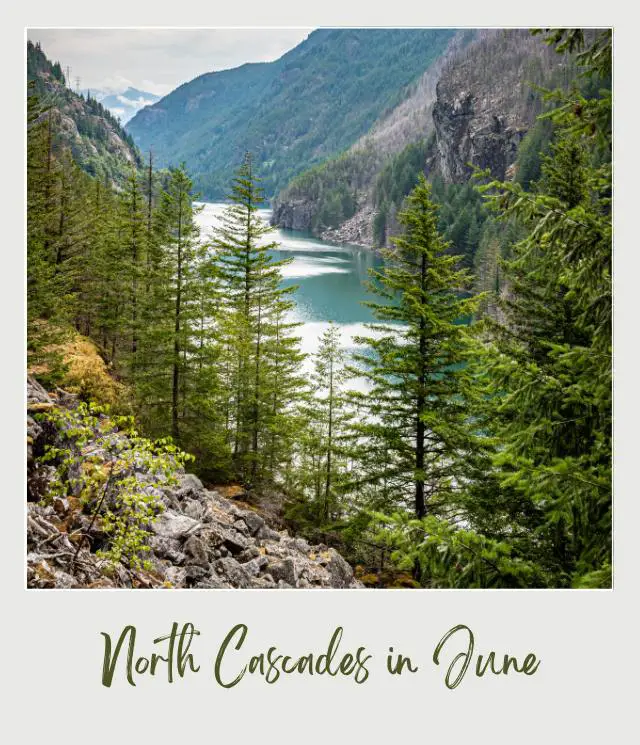
Head to North Cascades in June and you can expect similar temperatures to September, at the start of fall. There’s usually a little more rain in June, though, with about 16 days of precipitation. So it will be wet, on average, every other day here, with some sunny days too.
June temperatures are in the range of 25°F (-4°C) to 46°F (8°C). Only July and August are warmer. So if you don’t like the cold, head here in summer!
Even in June, you can still expect to see some snow at North Cascades, especially at high elevations. When packing your hiking gear, it’s therefore best to prepare for walking over some snowy parts with microspikes for hiking. Due to cold overnight temperatures, modest daytime highs and a changeable climate, packing plenty of layers is also the best approach. Even when you’ll be visiting North Cascades in summer.
The peak tourist season starts here in late May, so by June you can expect the park to be getting busier. You can also expect park facilities to be fully operational by now.
Pros
- Quieter than July and August
- It only rains about every other day
- Park amenities are now fully operational
Cons
- It’s getting busier
- Colder than the following two months
- There are still some snowy patches on the trails
Visiting North Cascades National Park in July
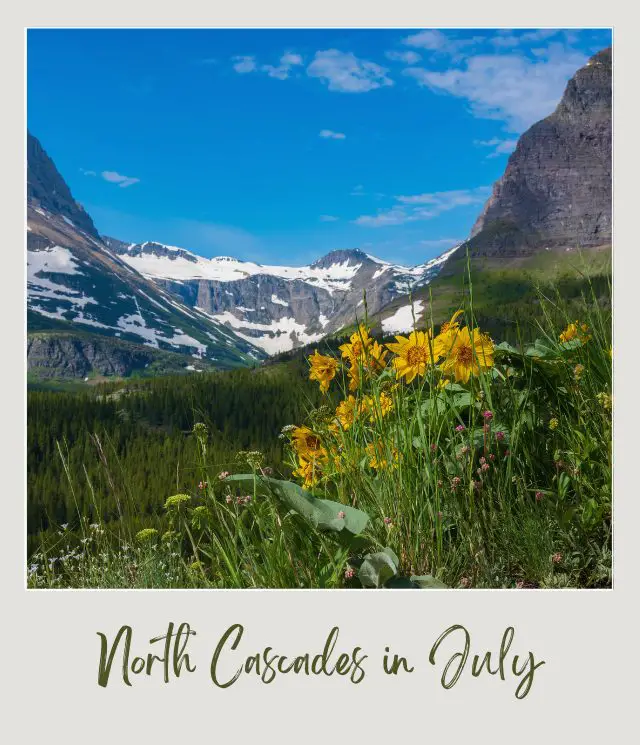
July is one of the warmest two months of the year at North Cascades National Park. On average, temperatures in July and August are comparable. Though it can be very slightly colder overnight in July.
The temperature at North Cascades in July ranges from about 28°F (-2°C) to around 54°F (12°C) so even though it’s summer, it’s still not hot. July is the driest month. With about 10 days of rain, you can expect it to rain once every three days on average.
If you don’t like getting wet, July is the best month to visit North Cascades National Park. Though it’s more likely to be warm and sunny than at any other time of year, it can still be wet and windy, however. So again, packing layers and waterproofs is a must.
The trails can also still have snowy patches in July, and may not clear until the middle or end of the month. This is peak tourist season, so you can also expect crowds.
Pros
- July is the driest month
- One of the warmest two months
- The best chance of sunny weather
Cons
- The park can be very busy
- It can still get wet and windy
- Trails may still have snowy patches until late July
Visiting North Cascades National Park in August
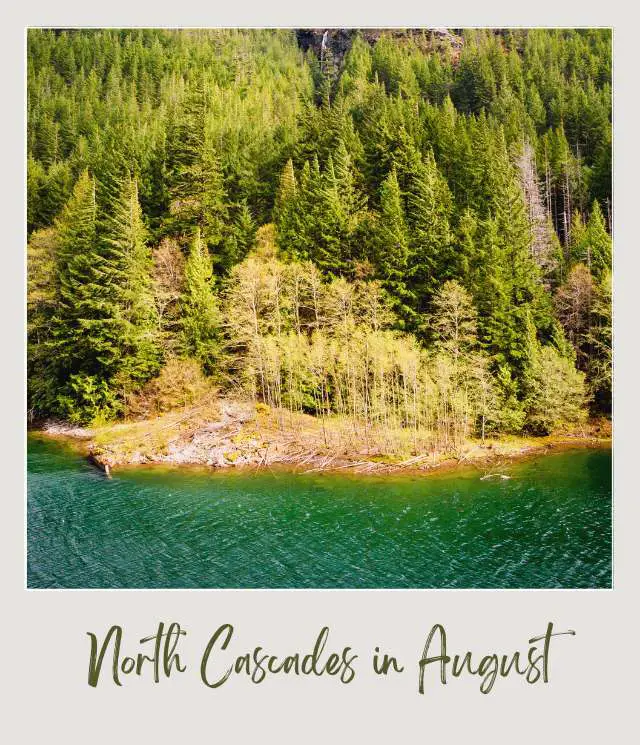
Head to North Cascades in Washington State during August and you’ll experience the warmest month of all. If you’re not familiar with the climate in this part of the world, though, be aware that below freezing temperatures aren’t that uncommon overnight even at the height of summer.
In August, you can expect daily lows of around 30°F (-1°C), with highs of about 54°F (12°C). Rainfall levels are a little higher than in July, but not by a lot. It should still be dry on more days than it’s wet.
August weather at North Cascades is cool and humid rather than cold and wet, making this one of the most popular months to visit. And therefore one of the busiest.
By now, it’s about as dry and snow-free as it’s ever going to get here on the trails, so this is the best month to hike in the mountains.
Pros
- The number one warmest month
- One of the driest times of the year
- Most snow will have melted away by now
Cons
- It’s not quite as dry as July
- One of the two busiest months
- It can still get very cold overnight
North Cascades National Park – Fall (September – October)
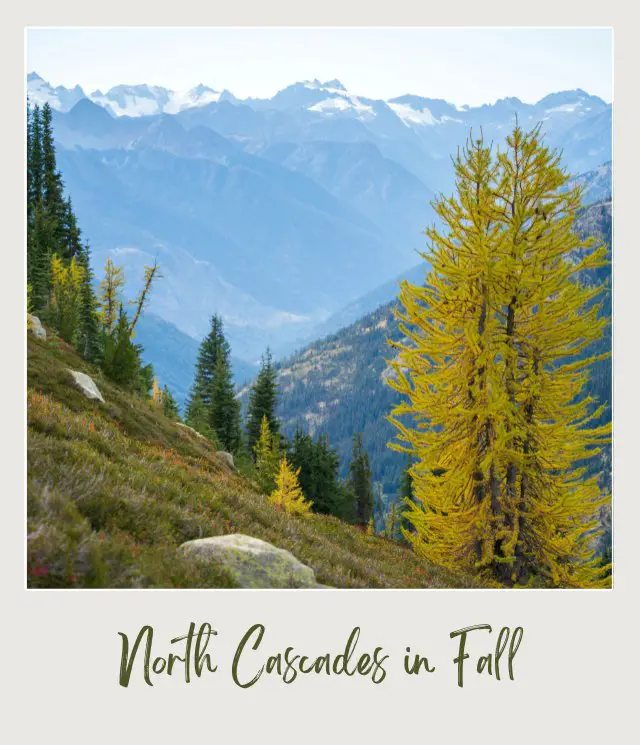
Fall in North Cascades National Park takes place during September and October. At North Cascades National Park in September, though, you can expect summer-like weather, with temperatures dropping further and rainfall levels increasing in October.
Visiting North Cascades National Park in September
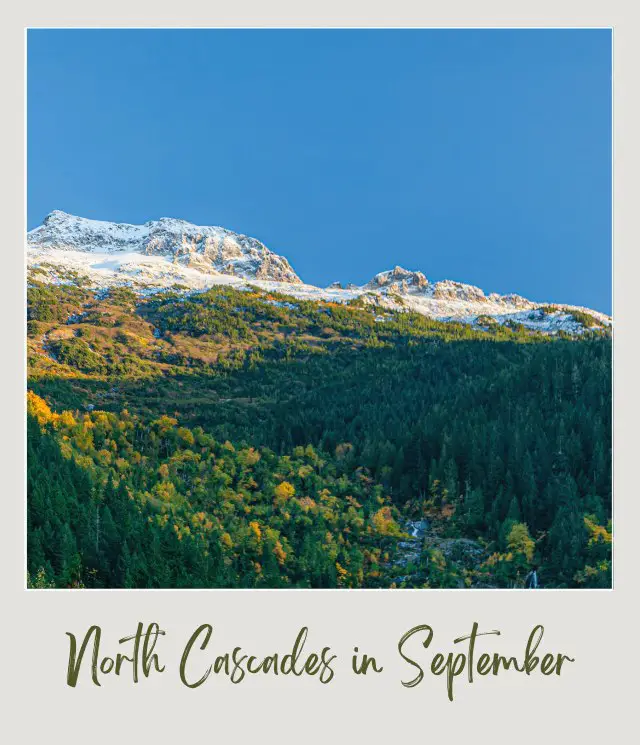
The North Cascades National Park weather in September is comparable to June in terms of temperature. And while it’s starting to get a little wetter than in July and August, this is still the third-driest month of the year.
As in June, expect temperatures that range from 25°F (-4°C) to 46°F (8°C). It’s likely to rain on a little under half of the days of the month. Because of the two drier, warmer months before, you also have a good chance of encountering snow-free trails in September.
This is a good time to visit as the summer crowds have dissipated, though the park can still be busier than during late fall, winter or spring. Facilities are usually fully open until the end of the month.
You can see fall colors here in late September.
This is my personal favorite time to visit North Cascades National Park – nice weather, no snow and fewer people.
Pros
- Among the warmer months
- Third-driest month of the year
- Most facilities remain operational (though campgrounds close early September)
- The larch and maple trees start to change color late September
Cons
- More rain than in summer
- Peak season continues in September
- Some facilities such as the campgrounds close early September
- Most facilities begin to close down at the end of the month
Visiting North Cascades National Park in October
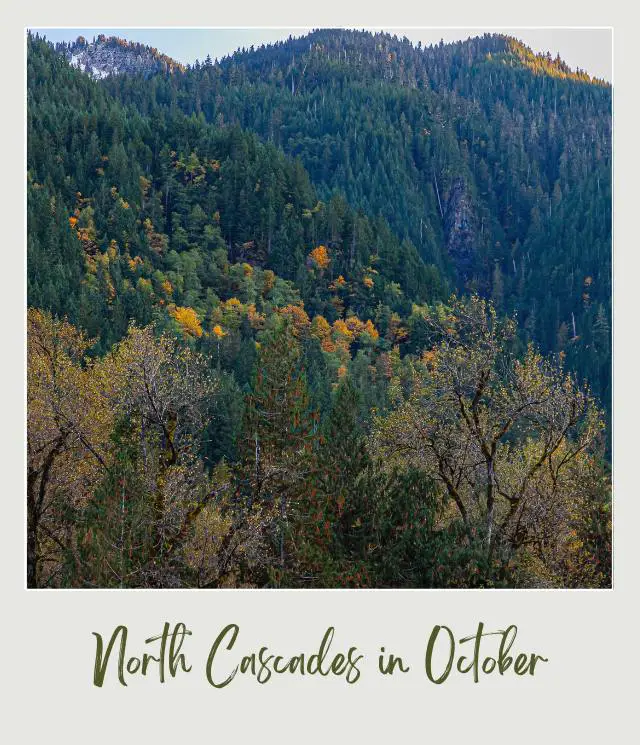
If you were looking at the whole year, then October makes a pretty good gauge of the North Cascades climate. Temperatures and rainfall levels are around average, and are comparable to the spring months of April and May.
Expect overnight lows of around 19°F (-7°C), with daytime temperatures peaking at about 34°F (1°C). So you’ll need plenty of warm clothing, and again layers are the best choice for this changeable climate. Around 19 days of precipitation is average for October at North Cascades National Park.
As many park facilities close at the end of September, visitors are not as well catered for here as in summer and early fall. It is more peaceful, though, and warmer and drier than during the following five months.
This is also the best month to see fall colors at the park. While hiking temperatures are cool, they are often pleasant.
Pros
- A good time to see fall colors, especially early in the month
- Not as cold or wet as the next five months
- More peaceful than in summer and early fall
Cons
- Peak season park facilities are now closed
- It’s getting pretty cold, especially by the end of the month
North Cascades National Park – Winter (November – March)
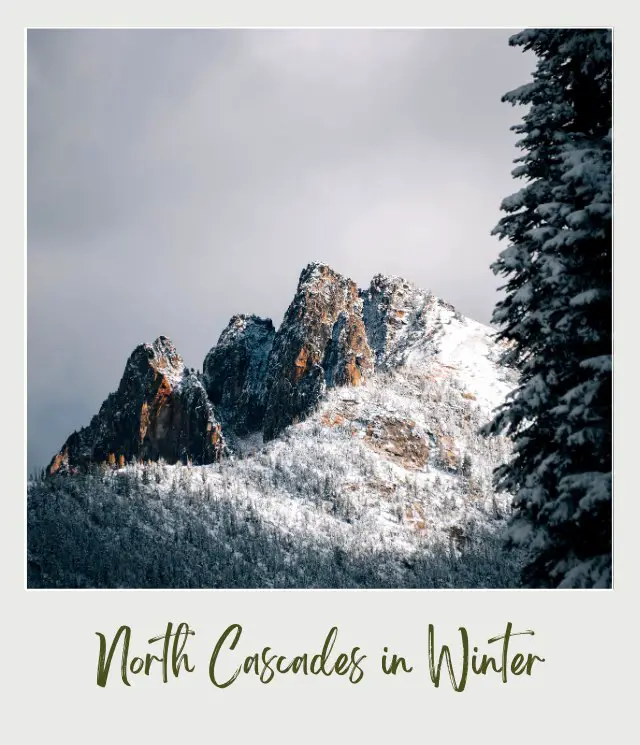
Visiting North Cascades National Park in winter isn’t for those who don’t like the cold. It’s a long season, too, lasting from November to March.
So is North Cascades National Park open in winter? Yes, it is in theory, though services are restricted and road access is limited. Highway 20, the road through the main section of the park is typically closed from late November / early December to April or early May.
Visiting North Cascades National Park in November
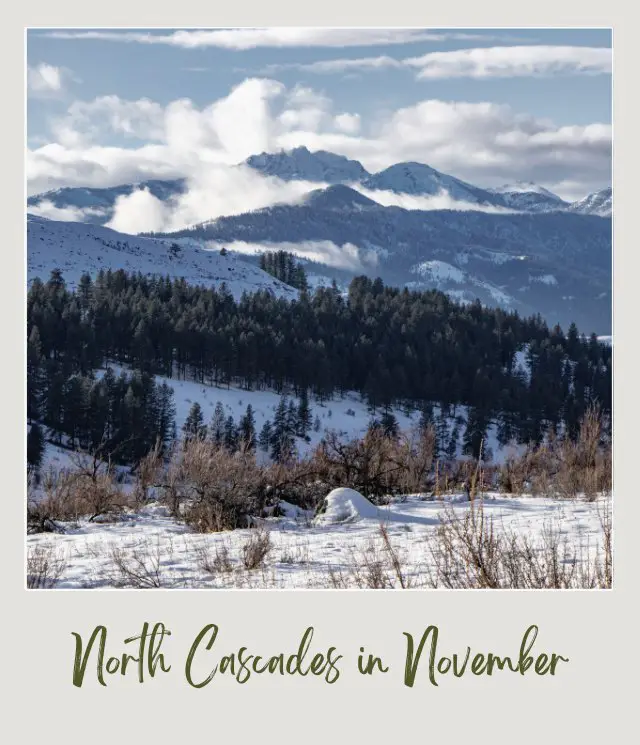
Go to North Cascades National Park in November and you can expect it to be colder than October and March, but warmer than December, January and February. This is among the wettest months, however, with about as much rain as December. Though it’s drier than March.
12°F (-11°C) is the minimum temperature you can expect overnight, on average. During the day, the mercury can climb to about 21°F (-6°C). So do come prepared for the cold!
It snows at North Cascades for about 24 days out of 30 in November. So you’ll need to bring waterproof outerwear and hiking boots, plus warm layers to wear by day and at night.
Park facilities are limited in November, but this does mean that the park is more peaceful. As temperatures stay below zero (in celsius) at this time of year, you can expect plenty of pretty snow-clad landscapes. This also restricts access to roads and trails, however.
Pros
- One of the quietest months
- Picturesque snowy landscapes
- Warmer than December, January and February
Cons
- Limited park facilities
- Access is likely to be restricted
- One of the wettest months of the year
- Highway 20 may close by the end of the month
Visiting North Cascades National Park in December
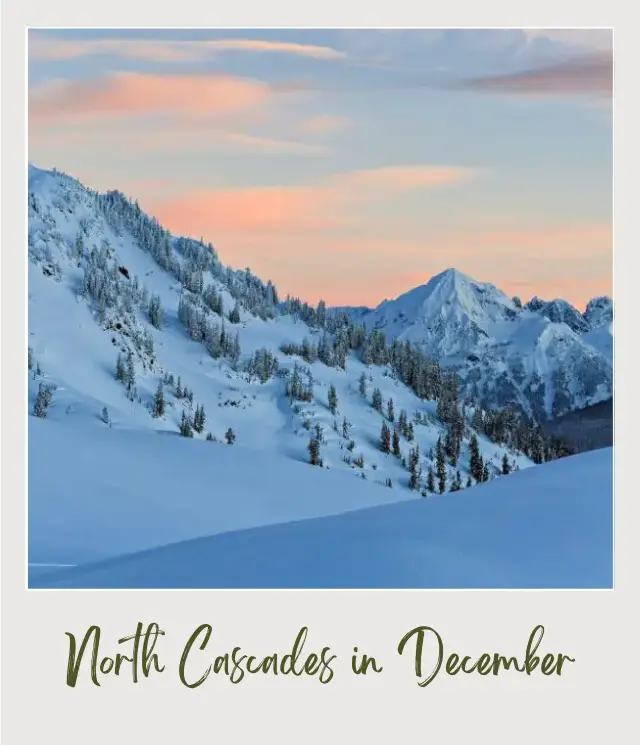
If you feel like a winter adventure at North Cascades National Park, then a December visit is an option. This is one of the coldest two months, though, with only marginally higher overnight lows than those you can expect in January.
In December, temperatures here range from highs of around 16°F (-9°C) to lows of about 7°F (-13°C). Precipitation levels are comparable to November, and you can expect to see snowfall on around 24 days of the month.
The park is pretty peaceful in December, and also very picturesque. The temperatures mean that it’s not for the faint-hearted, however. Access to roads and trails will also be weather-dependent and therefore restricted, so it’s best to be flexible if you want to visit in midwinter.
Many park amenities are also closed outside of the summer season.
Pros
- Pretty wintry landscapes
- A peaceful time of the year
- Expect snow rather than rain
Cons
- Limited park facilities are open
- Highway 20 will be closed for all or most of the month
- One of the coldest two months
- Accumulated snow restricts road access
Key Events in December:
✳️ Skagit Eagle Festival during December and January
Visiting North Cascades National Park in January
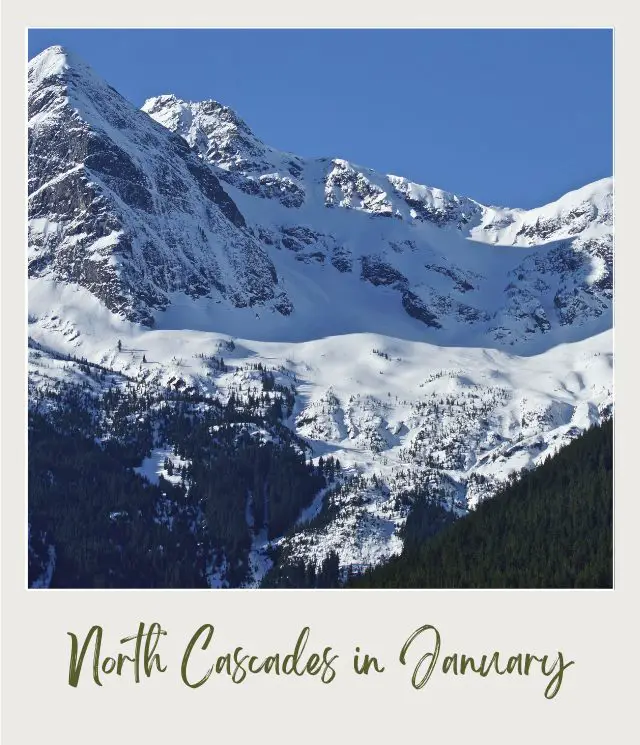
Head to North Cascades in January and you might almost have the place to yourself. The Christmas and New Year holidays are over, and the cold puts many people off visiting in January. This is the chilliest month of all.
Temperatures ranging from 7°F (-14°C) to 16°F (-9°C) can be expected in January. But if you don’t mind the cold and are feeling adventurous, then this can be a good time to explore the park without the crowds.
With around 22 days of snow in January, it’s a little drier than during the preceding winter months of November and December. Just don’t expect too much to be open – and be prepared to be flexible. And plan for the extreme cold.
Pros
- No crowds
- Unspoiled landscapes
- Very peaceful time to visit
Cons
- Few park facilities
- The coldest month of all
- Expect road and trail closures. Highway 20 will be closed
Key Events in (January)
✳️ Skagit Eagle Festival during December and January
Visiting North Cascades National Park in February
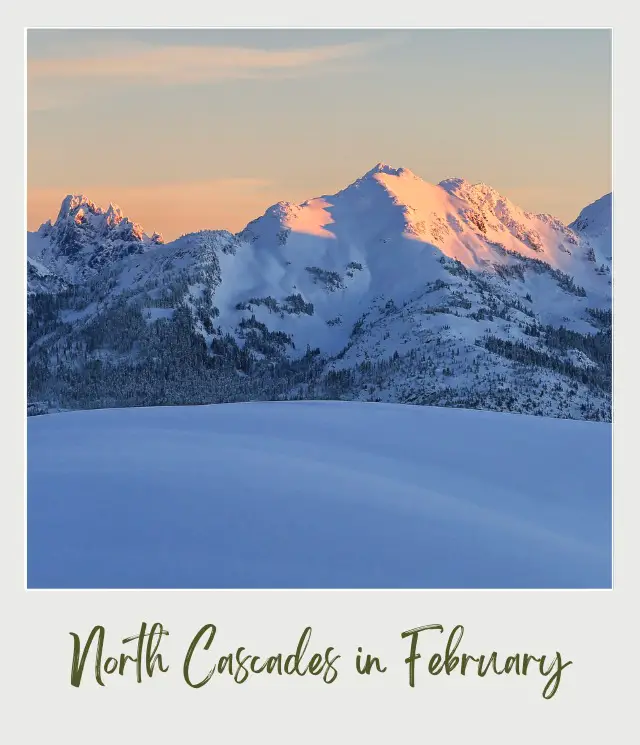
February at North Cascades is a little warmer than December and January. Temperatures are fairly similar to November’s, but there is less precipitation in late winter than during late fall.
You can expect daytime highs of around 19°F (-7°C), with overnight lows of about 9°F (-13°C). So you’ll still need very warm clothing, including lots of layers. Snow falls on around 20 days in February – or on two out of every three days.
Again, access is restricted and there are few facilities open, but you can expect pristine snowy landscapes and perfect peace if you head to North Cascades in February. For those who are happy to go with the flow – and prepared for the cold weather – this can be a lovely time to visit.
Pros
- Very peaceful
- Pristine snowy landscapes
- A little warmer and drier than December and January
Cons
- Limited amenities
- It’s still very cold indeed
- Restricted access to roads and trails. Highway 20 will be closed
Visiting North Cascades National Park – March
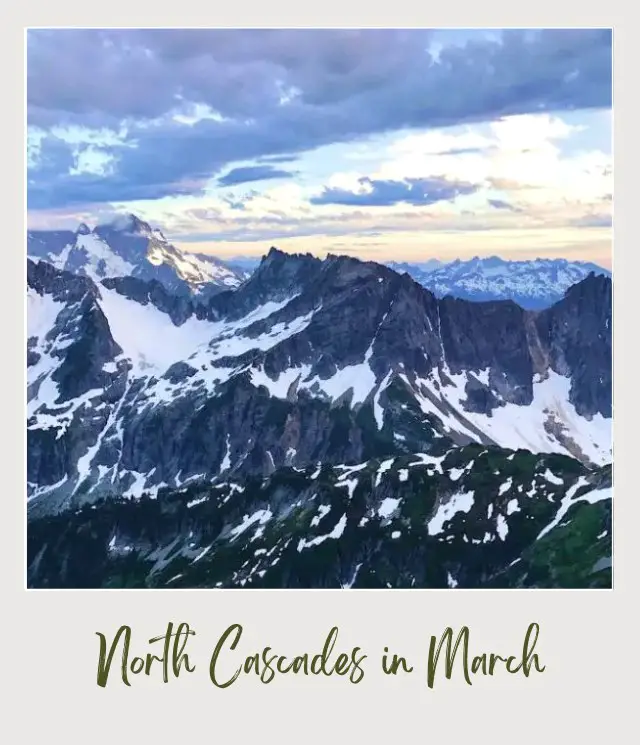
If you want to head to North Cascades National Park in March, then what should you expect? This is the warmest of the winter months, though it’s colder than spring or fall. March is also the wettest month, but due to the temperatures you can expect snow rather than rain.
For March, lows of around 25°F (-4°C) and highs of about 10°F (-12°C) are average. Precipitation can be expected on most days, but as this falls as snow, you won’t get as soaked as during heavy rain.
Again the park is peaceful and unspoiled, with limited access and amenities. The accumulation of snow can also pose extra problems, as several months’ worth will have fallen by this point. If you’re flexible and adventurous, though, March may be a good time to visit.
Pros
- A quiet time to visit
- The warmest winter month
- Snowy rather than wet and rainy
Cons
- Few facilities are open
- The wettest month of the year
- Accumulated snow restricts access. Highway 20 will be closed
Travel Insurance for North Cascades National Park
When visiting North Cascades National Park, you should definitely get travel insurance. This can protect you not only against medical and emergency repatriation, but can also cover things like trip cancellation, loss and/ or theft of property, etc.
➡️ A great insurance option is Travelex. It has coverage for all you’ll need. You can compare Travel Insurance plans here or get a quote right now:
Enjoy North Cascades National Park!
More Planning Resources for North Cascades National Park
⭐ North Cascades National Park Guide
⭐ Planning A Trip to North Cascades National Park: 7 Mistakes to Avoid
⭐ How To Get to North Cascades National Park
⭐ The Airports Near North Cascades National Park
⭐ The Closest Airport to North Cascades National Park
⭐ Best Time To Visit North Cascades National Park
⭐ 10 Tips For Visiting North Cascades National Park
⭐ 10 Fun Facts About North Cascades National Park
What do you think is the best time of year to visit North Cascades National Park? Join my private Facebook group National Parks Collectors and comment and let me know (you can also pick up extra planning tips, share your photos and stories with other national park lovers and more).
Subscribe to daily national parks planning tips, travel inspiration and trip ideas and get instant access to the free PDF of this guide to
Visiting North Cascades National Park Throughout The Year
If you liked this article about when to visit North Cascades National Park, Pin It to your North Cascades National Park board!


💡 Are you just starting to think about taking a national parks trip? Get Inspiration
‼️ Are you looking for helpful tips for visiting US national parks? Read articles that share useful tips on a range of national-park related issues
💻 Are you starting to plan a trip to North Cascades National Park? Read my Guide to North Cascades National Park
💲 Are you ready to book your trip? Use these Planning and Booking Resources
📖 Do you want to read a book about US national parks? Check out my Recommended Reading Lists
About the Author
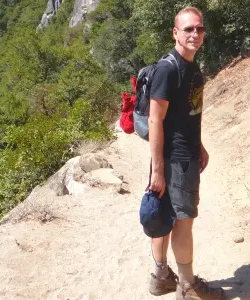
James Ian is a national park, camping and hiking expert.
He has dedicated his life to travel, visiting more than 80 countries, all 7 continents and most of the national parks in the United States. With over 35 years experience in the travel industry, James has worked on cruise ships, at resorts and hotels, and as a travel planner who’s helped hundreds of people plan successful trips to US national parks.
Based on his experience visiting our national parks multiple times, in-depth research and expertise as a travel planner, James has published detailed itineraries for many of the major national parks in the US. These itineraries, as well as in-depth park guides, and other resources will help you have your own incredible trip to US national parks without stress and hassle.
As a national park expert, James has contributed to many publications, including USA Today, Newsweek, Time Business News, Savoteur, Best Trip, and Wired.
I’m a member of the Amazon Services LLC Associates Program. As an Amazon Associate I earn from qualifying purchases.
